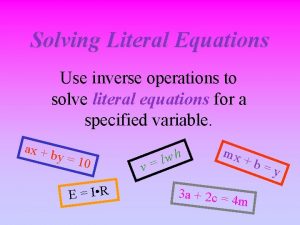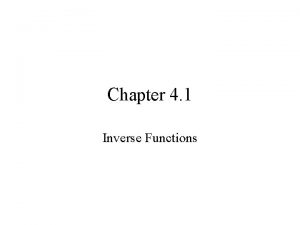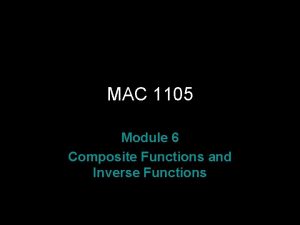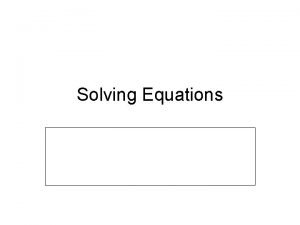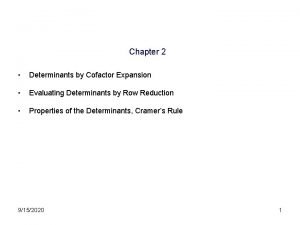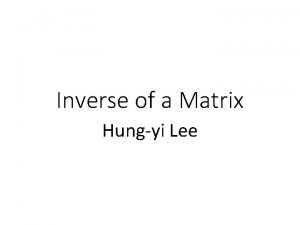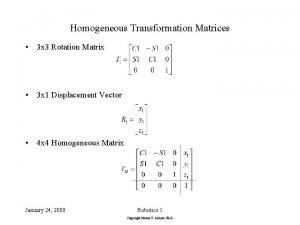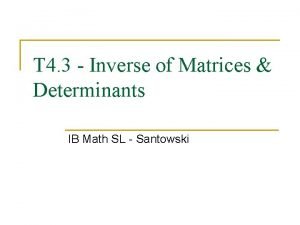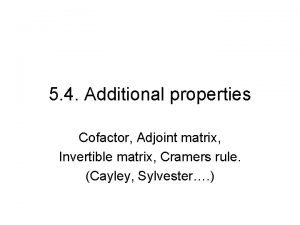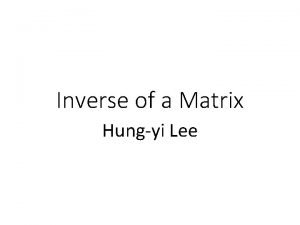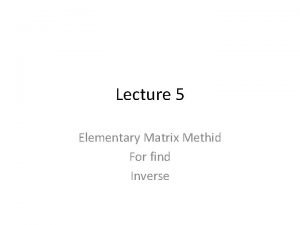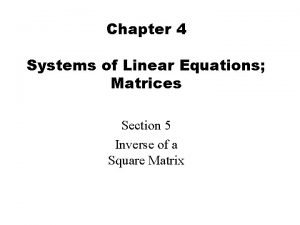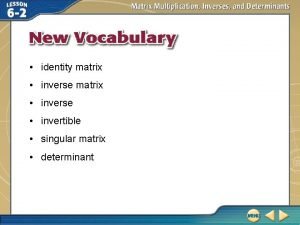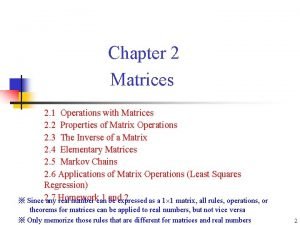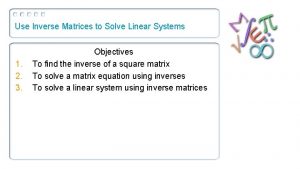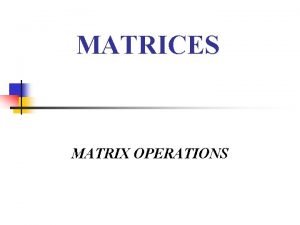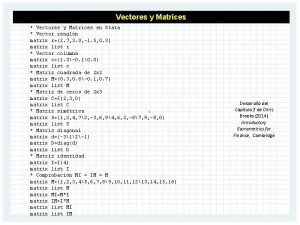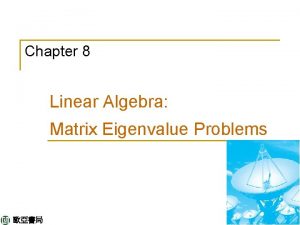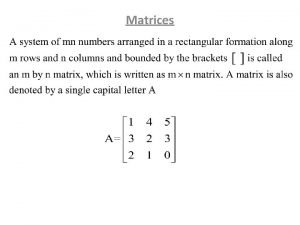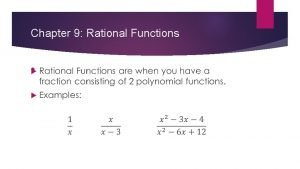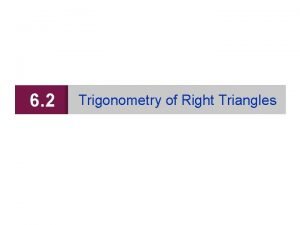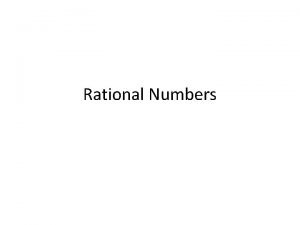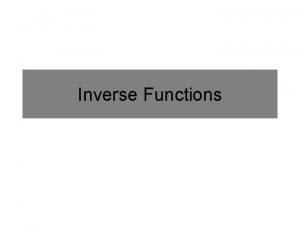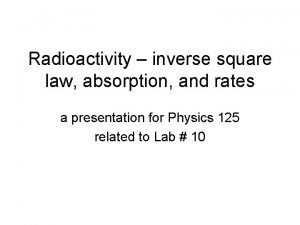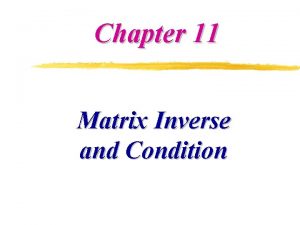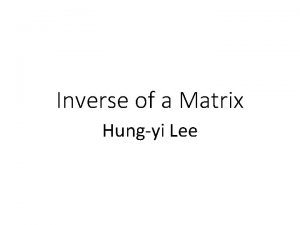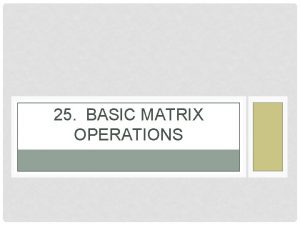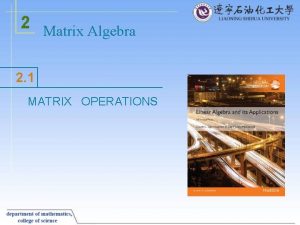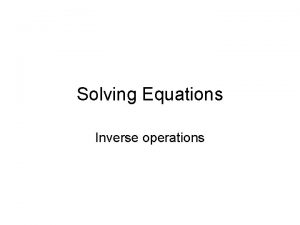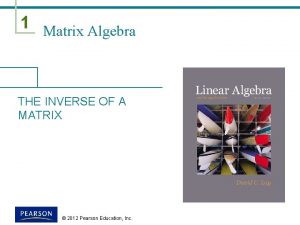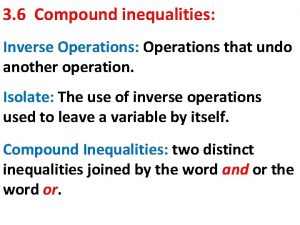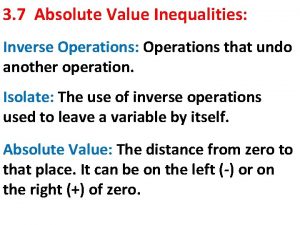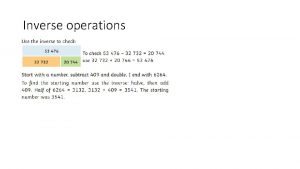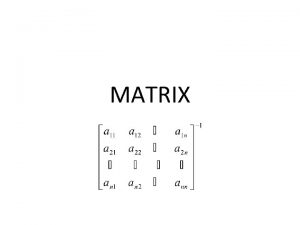w Matrix Operations w Inverse of a Matrix


















































- Slides: 50




w. Matrix Operations w. Inverse of a Matrix w. Characteristics of Invertible Matrices …

w. Partitioned Matrices w. Matrix factorization w. Iterative Solutions of linear Systems

w. Vector Spaces and Subspaces w. Null Spaces, Column Spaces and Lin Tr. w. Lin Ind. Sets: Bases …

w. Coordinate Systems w. Dim. of a Vector Spaces w. Rank w. Change of Basis w. Application to Diff Eq.

Let V be an arbitrary nonempty set of objects on which two operations are defined, addition and multiplication by scalars.

If the following axioms are satisfied by all objects u, v, w in V and all scalars l and m, then we call V a vector space.

Axioms of Vector Space For any set of vectors u, v, w in V and scalars l, m, n: 1. 2. u + v is in V u+v=v+u

3. u + (v + w) = (u + v) + w 4. There exist a zero vector 0 such that 0+u=u+0=u 5. There exist a vector –u in V such that -u + u = 0 = u + (-u)

6. (l u) is in V 7. l (u + v)= l u + l v 8. m (n u) = (m n) u = n (m u) 9. (l + m) u = I u +m u 10. 1 u = u where 1 is the multiplicative identity

A subset W of a vector space V is called a subspace of V if W itself is a vector space under the addition and scalar multiplication defined on V.

If W is a set of one or more vectors from a vector space V, then W is subspace of V if and only if the following conditions hold:

Continue! (a) If u and v are vectors in W, then u + v is in W (b) If k is any scalar and u is any vector in W, then k u is in W.

The null space of an m x n matrix A (Nul A) is the set of all solutions of the hom equation Ax = 0 Nul A = {x: x is in Rn and Ax = 0}

The column space of an m x n matrix A (Col A) is the set of all linear combinations of the columns of A.

The column space of a matrix A is a m subspace of R.

A system of linear equations Ax = b is consistent if and only if b is in the column space of A.

A linear transformation T from V into W is a rule that assigns to each vector x in V a unique vector T (x) in W, such that

(i) T (u + v) = T (u) + T (v) for all u, v in V, and (ii) T (cu) = c T (u) for all u in V and all scalars c

The kernel (or null space) of such a T is the set of all u in V such that T (u) = 0.

An indexed set of vectors {v 1, …, vp} in V is said to be linearly independent if the vector equation has only the trivial solution, c 1=0, c 2=0, …, cp=0

The set {v 1, …, vp} is said to be linearly dependent if (1) has a nontrivial solution, that is, if there are some weights, c 1, …, cp, not all zero, such that (1) holds. In such a case, (1) is called a linear dependence relation among v 1, … , vp.

Spanning Set Theorem Let S = {v 1, … , vp} be a set in V and let H = Span {v 1, …, vp}. (a) If one of the vectors in S, say vk, is a linear combination of the remaining vectors in S, then the set formed from S by removing vk still spans H. (b) If H {0}, some subset of S is a basis for H.

Suppose the set B = {b 1, …, bn} is a basis for V and x is in V. The coordinates of x relative to the basis B (or the Bcoordinates of x) are the weights c 1, … , cn such that …

If c 1, c 2, …, cn are the BCoordinates of x, then the vector in Rn is the coordinate of x (relative to B) or the B-coordinate vector of x. The mapping x [x]B is the coordinate mapping (determined by B)

If V is spanned by a finite set, then V is said to be finite -dimensional, and the dimension of V, written as dim V, is the number of vectors in a basis for V. …

Continue! The dimension of the zero vector space {0} is defined to be zero. If V is not spanned by a finite set, then V is said to be infinite-dimensional.

The pivot columns of a matrix A form a basis for Col A.

The Basis Theorem Let V be a p-dimensional vector space, p> 1. Any linearly independent set of exactly p elements in V is automatically a basis for V. Any set of exactly p elements that spans V is automatically a basis for V.

The dimension of Nul A is the number of free variables in the equation Ax = 0. The dimension of Col A is the number of pivot columns in A

The rank of A is the dimension of the column space of A. Since Row A is the same as Col AT, the dimension of the row space of A is the rank of AT. The dimension of the null space is sometimes called the nullity of A.

The Rank Theorem The dimensions of the column space and the row space of an m x n matrix A are equal. This common dimension, the rank of A, also equals the number of pivot positions in A and satisfies the equation rank A + dim Nul A = n

If A is an m x n, matrix, then (a) rank (A) = the number of leading variables in the solution of Ax = 0 (b) nullity (A) = the number of parameters in the general solution of Ax = 0

If A is any matrix, then rank (A) = rank T (A )

Four Fundamental Matrix Spaces Row space of A Column space of A Null space of AT

Let A be an n x n matrix. Then the following statements are each equivalent to the statement that A is an invertible matrix. …

The columns of A form a basis of Rn. Col A = Rn dim Col A = n rank A = n Nul A = {0} dim Nul A = 0

Let B = {b 1, … , bn} and C = {c 1, … , cn} be bases of a vector space V. Then there is an n x n matrix such that …

Continue! The columns of are the C-coordinate vectors of the vectors in the basis B. That is, …

Observe

Given scalars a 0, … , an, with a 0 and an nonzero, and given a signal {zk}, the equation is called a linear difference equation (or linear recurrence relation) of order n. …

Continue! For simplicity, a 0 is often taken equal to 1. If {zk} is the zero sequence, the equation is homogeneous; otherwise, the equation is nonhomogeneous.

If an 0 and if {zk} is given, the equation yk+n+a 1 yk+n-1+…+an-1 yk+1+anyk=zk, for all k has a unique solution whenever y 0, …, yn-1 are specified.

The set H of all solutions of the nth-order homogeneous linear difference equation yk+n+a 1 yk+n-1+…+an-1 yk+1+anyk=0, for all k is an n-dimensional vector space.

Reduction to Systems of First-Order Equations A modern way to study a homogeneous nth-order linear difference equation is to replace it by an equivalent system of first order difference equations, …

Continue! written in the form xk+1 = Axk for k = 0, 1, 2, … Where the vectors xk are in Rn and A is an n x n matrix.


 Solving equations inverse operations
Solving equations inverse operations Inverse operations addition
Inverse operations addition Inverse operations
Inverse operations Inverse operations
Inverse operations Inverse operations
Inverse operations Is it a function if x repeats
Is it a function if x repeats Inverse operations
Inverse operations Opposite of inverse
Opposite of inverse Algebra jeopardy
Algebra jeopardy Inverse of a matrix definition
Inverse of a matrix definition Properties of determinant
Properties of determinant Det(ka)
Det(ka) Matrix inverse vs transpose
Matrix inverse vs transpose Homogenous transformation matrices
Homogenous transformation matrices Site:slidetodoc.com
Site:slidetodoc.com The inverse of matrix a is written as a-1 so that aa-1=?
The inverse of matrix a is written as a-1 so that aa-1=? Can matrices be divided
Can matrices be divided Is adjoint and transpose same
Is adjoint and transpose same Elementary matrix example
Elementary matrix example What is elementary matrix
What is elementary matrix How to find the inverse of a matrix 3x3
How to find the inverse of a matrix 3x3 Simulink inverse matrix
Simulink inverse matrix Matrix multiplication definition
Matrix multiplication definition Inverse matrix code
Inverse matrix code Excel identity matrix
Excel identity matrix How to find the inverse of 3 by 3 matrix
How to find the inverse of 3 by 3 matrix Elementary matrix example
Elementary matrix example Elementary matrix
Elementary matrix Matrix inverse gaussian elimination
Matrix inverse gaussian elimination Use inverse of matrix to solve linear system
Use inverse of matrix to solve linear system Inverse matrix formula
Inverse matrix formula Technology process definition
Technology process definition 2*2 matrix
2*2 matrix Matrices stata
Matrices stata Matlab matrix operations
Matlab matrix operations Distinct eigenvalues
Distinct eigenvalues Agnes csaki semmelweis
Agnes csaki semmelweis Filetype:pdf
Filetype:pdf Boolean algebra
Boolean algebra Unitary matrix
Unitary matrix Blood has a fluid matrix name thin matrix
Blood has a fluid matrix name thin matrix Skew matrix example
Skew matrix example Simple matching coefficient
Simple matching coefficient Multiplication of diagonal matrix
Multiplication of diagonal matrix Vertasy
Vertasy Inverse of rational functions
Inverse of rational functions Six trigonometric ratios
Six trigonometric ratios Inverse property
Inverse property Inverse relations and functions
Inverse relations and functions Inverse square law
Inverse square law Formule inverse concentrazioni percentuali
Formule inverse concentrazioni percentuali
